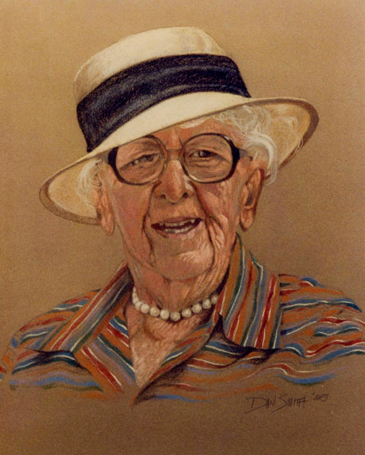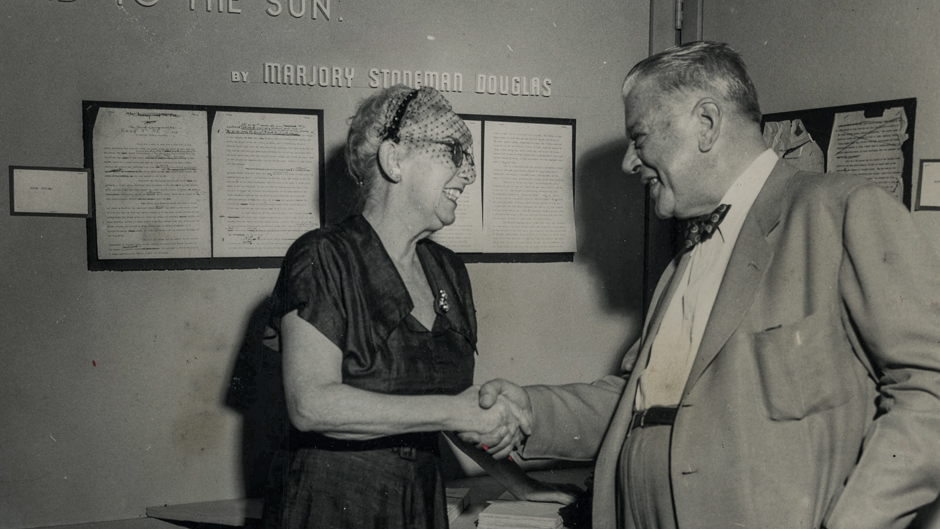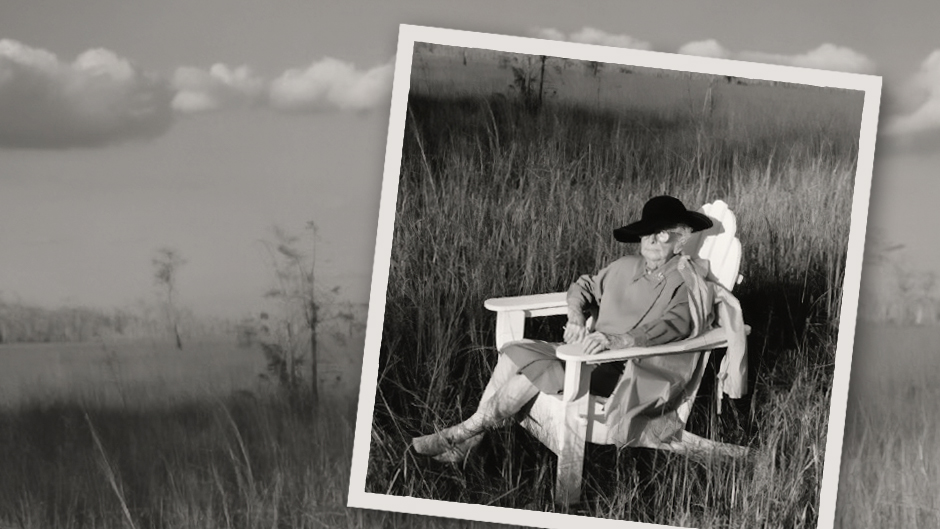She was a woman ahead of her time. A visionary. A journalist. A lover of nature. A force to be reckoned with.
Marjory Stoneman Douglas, also known as the “Mother of the Everglades,” was a staunch proponent of conserving the environment. An exhibition will open at University of Miami Libraries’ Kislak Center on Nov. 30, with a 6 p.m. reception titled, “The Enduring Legacies of Marjory Stoneman Douglas.”
Inspired by Stoneman Douglas’s life, the exhibition will feature many of the items from the Marjory Stoneman Douglas papers housed in the Libraries’ Special Collections department. It will also feature items highlighting environmental groups who were directly inspired by her lifelong battles to conserve the “river of grass,” a phrase that she coined in her iconic book The Everglades: River of Grass.”
Stoneman Douglas' tenacity and doggedness in her struggle to preserve the delicate ecosystem of the Everglades, although irritating to her opponents or to those whose commercial interests were foiled by her tenacious dedication, was key to her success in attracting allies and succeeding in her environmental strategies, stated Cristina Favretto, director of Special Collections, in a recent Zoom presentation titled, “Be a Nuisance Where it Counts,” a phrase inspired by a famous Stoneman Douglas quote.
“She was a fabulous nuisance,” said Favretto. “Her work has had a far-reaching impact on Miami and South Florida and the world of environmentalists. We need more Marjorys, and we need to honor her legacy and ensure that her work continues to inspire.”
Photos, postcards, pamphlets, newspaper articles, awards, and even an initial draft of the unpublished manuscript for her book are all part of the exhibition. Another glass case holds a picture of Stoneman Douglas’ first published story called “An early morning paddle.” She wrote it as a child and it was submitted to the Boston Herald, where it won a prize.
Born in 1890 in Minneapolis, Minnesota, Stoneman Douglas moved to Miami in 1915 to be reunited with her father. Her mother had died of cancer. Her father was an activist and the editor of the newspaper that would later become the Miami Herald.
“She fell in love with Florida and Miami, and was particularly entranced with the physical environment; the vegetation, landscape, sunsets, water,” said Favretto. “She felt, as she was quoted saying, that she was ‘being given a long embrace’.”
Stoneman Douglas worked for her father’s newspaper as a columnist and later worked as a freelance writer penning articles on a variety of topics.
She also wrote poetry, popular short stories, and plays, including one based on gangster Al Capone’s life, said Favretto.
When a friend asked her to write a book about the Miami River for the popular “Rivers of America” series, Stoneman Douglas—who declared that the Miami River was "only and inch and a half long"—proposed that she write about the Everglades, which she considered an essential riverway sustaining a complex and important ecosystem.
After the success of her book, she became an important and effective champion of the Everglades. She was effective in recruiting other activists, including the celebrated, Miami-based botanist David Fairchild, in her battle to save the wetlands from the threat of urbanization.
“This region was menaced by rapid growth of the area, unprecedented real estate deals engendered haphazard construction and environmentally destructive urban growth,” Favretto said. “Eventually, in their greed, developers started envisioning a project for paving over large parts of the Everglades to allow room for even more dense housing schemes.”
Several environmental groups saw this development as a disaster and enlisted Stoneman Douglas’s help in advocating against encroachment of the Everglades. The collection of her papers includes hundreds of letters from her to politicians, including former Florida U.S. House Rep. Dante Fascell and former Florida Gov. Bob Graham, advocating for preserving the river of grass.
She was a great fan of the University of Miami and admired the work of its first president, Bowman Foster Ashe. On June 9, 1952, Ashe granted her an honorary degree as a Doctor of Humane Letters. In 1947, she attended the dedication of the Everglades National Park, when President Harry S. Truman said, “Here is land, tranquil in its quiet beauty, serving not as the source of water, but as the last receiver of it.”

She was the founder of Friends of the UM Libraries and the non-profit organization Friends of the Everglades.
Eve Samples, executive director of Friends of the Everglades, will also speak at the event on Nov. 30.
“Marjory spoke truth to power and held politicians accountable for decisions impacting Florida's unique and iconic River of Grass,” Samples said. “Since Marjory's lifetime, the challenges facing our natural environment have intensified—making her legacy of bold advocacy all the more essential. Marjory founded Friends of the Everglades in 1969 to preserve, protect, and restore the only Everglades in the world, and we're proud to march forward in her footsteps today."
Stoneman Douglas died in 1998 at the age of 108.

